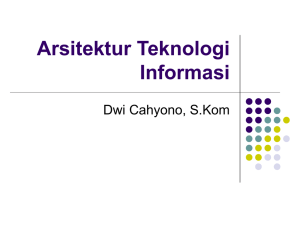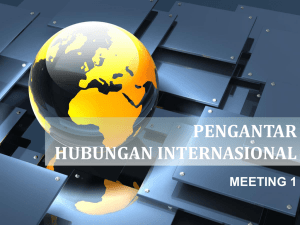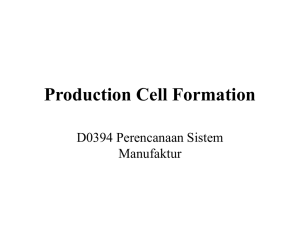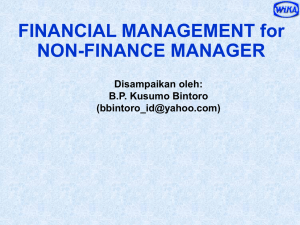PEMELIHARAAN & PERBAIKAN MESIN - TIN416
advertisement
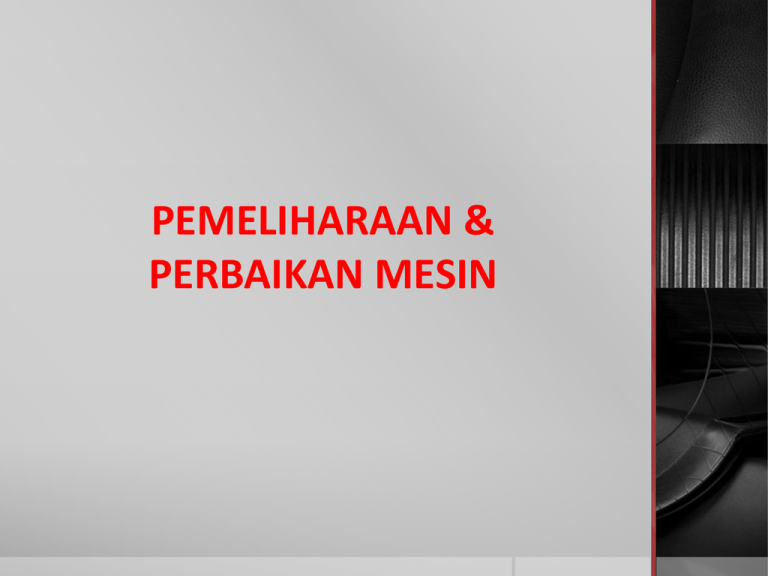
PEMELIHARAAN & PERBAIKAN MESIN Kegagalan (Failure) Failure – ketidakmampuan untuk melakukan kerja dengan appropriate manner Equipment / machine failure on production floor – worn out bearing, pump, pressure leaks, broken shaft, overheated machine etc. Equipment failure in office – failure of power supply, airconditioned system, computer network, photocopy machine Vehicle failure – brake, transmission, engine, cooling system Konsekuensi Permasalahan Mesin Masalah Mesin Malfunction Breakdown Dampak Langsung Biaya / Konsekuensi Akhir Deteriorasi mesin Umur mesin singkat Ketidakefisienan mesin Biaya perbaikan tinggi Variabilitas output Scrap dan rework Bahaya keselamatan Cedera Pekerja menganggur Persediaan Fasilitas menganggur Biaya perbaikan tinggi Penundaan jadwal Pemeliharaan (Maintenance) Semua aktivitas untuk memelihara fasilitas dan mesin serta peralatan bekerja dengan baik sehingga sistem dapat bekerja sebagaimana dimaksudkan Meliputi: servicing, repair, modification, overhaul, inspection and condition verification Increase availability of a system Keep system’s equipment in working order Maintenance in Manufacturing Companies Electronic Automotive Petrochemicals Refinery Furniture Ceramics Food and beverages Tujuan Pemeliharaan Upaya untuk memaksimalkan kinerja mesin dan peralatan secara efisien dan teratur Prevent breakdown or failures Minimize production loss from failures Increase reliability of the operating systems Tujuan Dasar Pemeliharaan (Principle Objectives in Maintenance) Mencapai kualitas produk dan kepuasan pelanggan melalui adjusted and serviced equipment Memaksimalkan usia pemakaian mesin dan peralatan Menjaga mesin dan peralatan aman dan mencegah bahaya keselamatan Meminimasi frekuensi dan lamanya interupsi atau gangguan Memaksimalkan kapasitas produksi – melalui utilisasi tinggi fasilitas Permasalahan dalam Pemeliharaan Kurangnya perhatian manajemen pada pemeliharaan Rendahnya partisipasi accounting dalam analisis dan melaporkan berbagai jenis biaya Kesulitan dalam menerapkan analisis kuantitatif Kesulitan dalam mendapatkan estimasi waktu dan biaya untuk pekerjaan pemeliharaan Kesulitan dalam pengukuran kinerja Maintenance Costs Cost to replace or repair Losses of output Delayed shipment Scrap and rework Tipe Pemeliharaan Reactive or Corrective Maintenance: Breakdown maintenance Reactive approach; dealing with breakdowns or problems when they occur Proactive Maintenance: Preventive maintenance Proactive approach; reducing breakdowns through a program of lubrication, adjustment, cleaning, inspection, and replacement of worn parts Corrective or Breakdown Maintenance Perbaikan dilakukan setelah mesin dan peralatan rusak dan tidak dapat melakukan fungsinya secara normal lagi Dapat dibenarkan untuk pabrik kecil dimana: Waktu kerusakan bersifat tidak kritis dan biaya perbaikan lebih rendah dari tipe pemeliharaan lainnya Alasan keuangan untuk penjadwalan tidak ada Kerugian Corrective Maintenance Breakdown generally occurs inappropriate times leading to poor and hurried maintenance Excessive delay in production & reduces output Faster plant deterioration Increases chances of accidents and less safety for both workers and machines More spoilt materials Direct loss of profit Scheduled Maintenance Scheduled maintenance is a stitch-in-time procedure and incorporates inspection lubrication repair and overhaul of equipment If neglected can result in breakdown Generally followed for: overhauling of machines changing of heavy equipment oils cleaning of water and other tanks etc. Preventive Maintenance (PM) Prinsip – “Prevention is better than cure” Prosedur - Stitch-in-time It locates weak spots of machinery and equipment provides them periodic/scheduled inspections and minor repairs to reduce the danger of unanticipated breakdowns Candidates for Preventive Maintenance Frequency of Failure Good candidates have more normal distribution with low variability Mean Time Between Failure (MTBF) Keuntungan PM Reduces break down and thereby down time Less odd-time repair and reduces over time of crews Greater safety of workers Lower maintenance and repair costs Less stand-by equipment and spare parts Better product quality and fewer reworks and scraps Increases plant life Increases chances to get production incentive bonus Kunci Keberhasilan Sistem PM Scheduling – Should be automated to the maximum extent possible Execution – Should be done before the actual break down occurs. Execution The Bath Tub Model – Three stages of new parts 1. Infant mortality stage 2. A fairly long run stage 3. Wear out stage Traditional View according to Bath Tub Model – Replace components just before they entered wear out stage Execution Traditional view says – Wear out stage = Increased rate of failure. Point to Ponder – Since, wear out stage represents increased rate of failure, wouldn’t it be plausible to execute the PM program at this stage? Fokus PM Cleaning Found through testing Lubrication and inspection And correcting deficiencies Predetermined parts replacement should be minimal and done only where statistical evidence clearly indicates wear-out characteristics Predictive (Condition-based) Maintenance In predictive maintenance, machinery conditions are periodically monitored and this enables the maintenance crews to take timely actions, such as machine adjustment, repair or overhaul It makes use of human sense and other sensitive instruments, such as audio gauge, vibration analyzer, amplitude meter, pressure, temperature and resistance strain gauges etc. Predictive Maintenance (Contd.) Unusual sounds coming out of a rotating equipment predicts a trouble An excessively hot electric cable predicts a trouble Simple hand touch can point out many unusual equipment conditions and thus predicts a trouble Maintenance Costs Cost Breakdown Cost Maintenance Commitment Maintenance Costs Cost PM Cost Breakdown Cost Maintenance Commitment Maintenance Costs Cost Total Maintenance Cost PM Cost Breakdown Cost Maintenance Commitment Maintenance Costs Cost Total Maintenance Cost PM Cost Breakdown Cost Optimal Maintenance Commitment Total Productive Maintenance (TPM) Komitmen untuk melakukan pemeliharaan melebihi preventive and predictive maintenance. Semua pekerja terlibat dalam pemenuhan kepuasan pelanggan, dimana pelanggan didefinisikan sebagai tahapan berikut dari sebuah proses Suatu kerusakan mesin dilihat sebagai defect, dan TPM berkomitmen untuk mencegah breakdown and malfunction TPM merupakan aspek lanjutan dari continous improvement, yang merupakan proses mengedukasi dan melibatkan pekerja, upgrading and redesigning equipment, penerapan foolproofing devices, memonitor kinerja mesin dan peralatan, dan mengeliminasi sumbersumber pemborosan mesin dan peralatan Total Productive Maintenance (TPM) TPM merupakan Japanese approach untuk • Membuat budaya perusahaan untuk efisiensi maksimum • Upaya mencegah kerugian dengan biaya minimum – Zero breakdowns and failures, Zero accident, and Zero defects etc • Esensi kerja tim (aktivitas kelompok kecil) berfokus pada kondisi dan performansi fasilitas-fasilitas untuk mencapai zero loss for improvement • Keterlibatan semua SDM mulai dari top management hingga operator TPM Production Operators • Clean & Check • Observe • Categorize Production Planning & Control • Schedule P.M. Active Planned Maintenance Process Manufacturing Engineers • Equipment Planning • Equipment Studies Quality Engineers • Standards & Calibrations Asal TPM A Socio-Technical System Manufacturing (and many other) systems have both technical and human/social aspects that are tightly bound and interconnected. Moreover, it is the interconnections more than individual elements that determine system performance. The technical system includes machinery, processes, procedures and a physical arrangement. We usually think of a factory in terms of its technical system. The social system includes people and their habitual attitudes, values, behavioral styles and relationships. It includes the reward system. It is the formal power structure as depicted on organization charts and the informal power structure deriving from knowledge and personal influence. Hasil Penerapan TPM 3M reduced their maintenance cost by 60% within three years. DuPont reduced off-quality by 69% and improved capacity by 29% in three years. Harley-Davidson estimates that the ROI from TPM has been ten-fold to the cost of implementation. Kodak reported a $5 million investment in TPM that resulted in a $16 million increase in profits.




